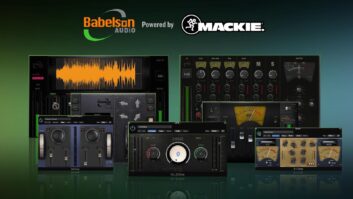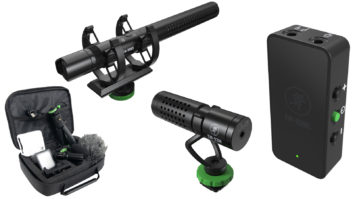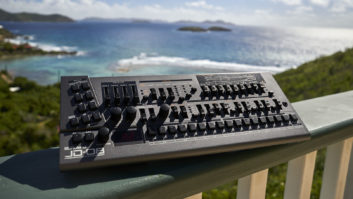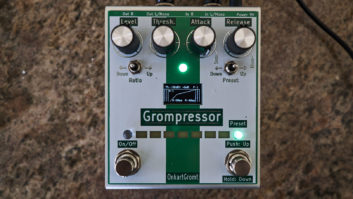
| MIX VERDICT: MACKIE THUMP GO |
| THE TAKEAWAY: “The Thump GOs provided balanced sound with crisp highs, tight lows and natural-sounding vocals—as long as you don’t expect to peel the paint off the walls. ” |
| COMPANY: Mackie • www.mackie.com PRICE: $449.99 each. Carry bag: $59.99; Spare battery: $89.99 PROS: • Compact, battery operation up to 12 hours. • Very good sound. • Snapshot recall via Thump Connect 2 app. CONS: • Limited SPL and low-end extension. • Battery gauge in Connect 2 does not display percentage. |
This was Mix’s 15th most-read article of 2022!
When it comes to portable, small-to-medium format loudspeakers, Mackie is no stranger to the market. The company’s SRM450 (now in V3) has become somewhat of a staple for working musicians as well as rental houses, and the Thump Series continues that tradition with the Thump GO, which can be powered via AC or by using an internal Lithium-Ion battery for up to 12 hours of operation. Putting that to the test, as soon as the Thump Go speakers turned up, I wasted no time grabbing them out of the box and putting them to use as wedge monitors for an electronic music concert.
The Thump GO is a two-way system, Class D–biamped with 175 watts (peak) for the 8-inch LF driver and 25 watts (peak) for the 1-inch HF compression driver. The asymmetrical enclosure is constructed entirely from textured black polypropylene, with a standard 1.5-inch pole mount on the bottom and a single handle on top. A perforated non-removable metal grille protects the drivers, and the entire package weighs in at a manageable 17.6 pounds.
Frequency range is spec’d as 57 Hz to 20 kHz (-3 dB down), and dispersion pattern is 90 x 60 degrees (H x V). Thump GO can be deployed vertically or horizontally as a wedge monitor, with an angle of 45 degrees. Thump GO is not intended to be suspended and does not incorporate any rigging hardware.
The bottom front of the speaker has a large LED power indicator that flashes slowly when the battery is charging and remains lit once the battery is fully charged (charge time ranges from three to four hours, depending upon whether the speaker is being used). At the bottom of the rear panel are a standard IEC receptacle and a power switch. Directly above these are the audio connectors and controls. Channel 1 has a combo jack input, gain control and a mic/ line switch, while channel 2 (line only) has gain control, a combo jack and a 1/8-inch TRS input.
Situated directly above the main volume knob are LEDs for overload and battery status. The manual warns that it’s okay to see the overload LED blink occasionally, but excessive limiting could lead to overheating—in which case, the thermal protection circuit shuts down the speaker for self-preservation.
The top of the rear panel hosts several LEDs and pushbutton switches. One switch toggles through four different EQ voicings: Music, Speech, Monitor or Sub (the manual shows additional settings for Megaphone and Whisper, but these are not present on the actual unit). These are self-explanatory, but in addition to engaging an LF cut (frequency unspecified), the Sub setting enables the Thump GO to play approximately 3 dB louder. I noticed a slight increase in volume in this mode.
The remaining rear-panel switches have built-in LEDs to indicate that they are active. Outdoor mode enhances the frequency response for use outdoors. Details aren’t revealed in the manual, but I heard either a slight reduction in the upper mids, or a slight boost in the top end. Music ducking enables a very clever ducking circuit whereby a signal applied to channel 1 (e.g., a vocal) will duck the audio on channel 2. Feedback Eliminator operates only on channel 1, employing up to six notch filters to eliminate feedback. The Front LED switch turns off the front panel power indicator.
GO THUMP GO
Like I said, I quickly used the Thump GOs as wedge monitors for an electronic music concert. Not knowing if the batteries were fully charged, I opted to power them via AC. Outputs from two aux sends of a digital mixer were patched into channel 1 on each Thump GO, mic/line switches set to Line, and the input gain controls set to 12 o’clock. I set the rear-panel Voicing Mode to Monitor and let it rip. The Thump GOs sounded good in this situation, though one of the artists complained that there wasn’t enough low end. I have since learned that the Monitor voicing reduces low end to compensate for the cabinet coupling with the floor, so the Music voicing might be the better choice for this particular situation.
Most of the Thump GO parameters can be controlled via Bluetooth using the Thump Connect 2 app, available free for iOS and Android devices (I ran it on both an iPad and iPhone). I’ll state up front that I have no love of Bluetooth, especially when used to stream audio. Static pops discharged when touching a device can disconnect the unit from a Bluetooth pairing, and that’s exactly what happened with the Thump GOs on one or two occasions.
RME Babyface Pro FS Audio Interface – A Real-World Review
NUGEN Audio Paragon ST – A Real-World Review
There are a few things to be aware of when using Connect 2 to control the Thump GO. The main volume control on the rear panel overrides the main fader in the app. To achieve maximum volume, the main volume control must be fully clockwise. Also, the app always opens the mixer to a “Default Snapshot” in which the faders for channel 1, 2, and main are at full level. The manual states that the main volume and gain controls on the speaker should be turned all the way down before powering up, and you’ll want to heed this warning.
Once you’ve paired the first speaker to a smart device, you can then link a second Thump GO to the first using the Link function, giving you control over the mix and the main volume level for both speakers.
A smart device can stream stereo audio to a pair of Thump GOs via Bluetooth, and it’s worth mentioning that you can simultaneously connect additional sources into the channel 2 combo jack and the 1/8-inch stereo jack while streaming audio via Bluetooth into channel 2 (note: the 1/8-inch TRS jack will sum a stereo signal to mono). These signals, however, will not be “beamed” over to the second Thump GO; to distribute audio to a second Thump GO, you’ll need to patch the thru connection from the first Thump GO into a channel on the second Thump GO.
Thump Connect 2 allows two Thump GOs to be used in Stereo Mode (as explained above) or in Zone mode, which is useful for situations where you want to use one speaker as a main and the other as a monitor (or for placing the speakers in separate areas). You’ll need the XLR thru connection to get hardwired signals from the first Thump GO to the second, and the mix will be the same for both speakers. Zone Mode permits independent control for the front LED, feedback eliminator, ducking, and provides custom EQ for each speaker.

A WEDGE AND A LOUDSPEAKER
The two-band EQ is accessible only using Connect 2 and features fixed low (80 Hz) and high (6.5 kHz) bands. Some folks might complain about a lack of flexibility, but given the target audience, Mackie has chosen well. You can’t make the Thump GOs sound bad even when the EQ is maxed.
When using the Thump GOs in a quiet room, you may hear some hiss from the Bluetooth input, and I noticed that there’s some sort of noise reduction being used that can cut off fade-ins and fade outs. Given the nature of the intended application (noisy environments), this will likely go unnoticed.
All of the features provided in the Thump GO speakers operate as intended. The Feedback Eliminator does what it’s supposed to, though I thought the reaction time could have been a bit faster. EQ was very smooth, and the various voicings worked well for their intended applications. I found the rear-panel controls easy to see and reach from a seated position when using the speaker as a floor monitor. Used in Stereo Mode for amplifying an electronic drum kit, Thump GOs did indeed have plenty of thump (sorry), and it was well-controlled.
I have a few minor gripes: I’d like to see battery percentage and current snapshot in the app. The manual suggests that linking a pair of Thump GOs wirelessly distributes all audio from the first to the second speaker, but this is only true of the Bluetooth input.
The Thump GOs provided balanced sound with crisp highs, tight lows and natural-sounding vocals—as long as you don’t expect to peel the paint off the walls. The HF horn is at the bottom of the cabinet so if you mount these on a pole, you’ll want to make sure that the horn is above the heads of the audience or you won’t get any HF dispersion to the rear of the room.
You could easily do a small coffee house gig with a pair of Thump GOs. You might even be able to load-in with a single trip from the car, and you won’t have to worry about where the AC service is located!








